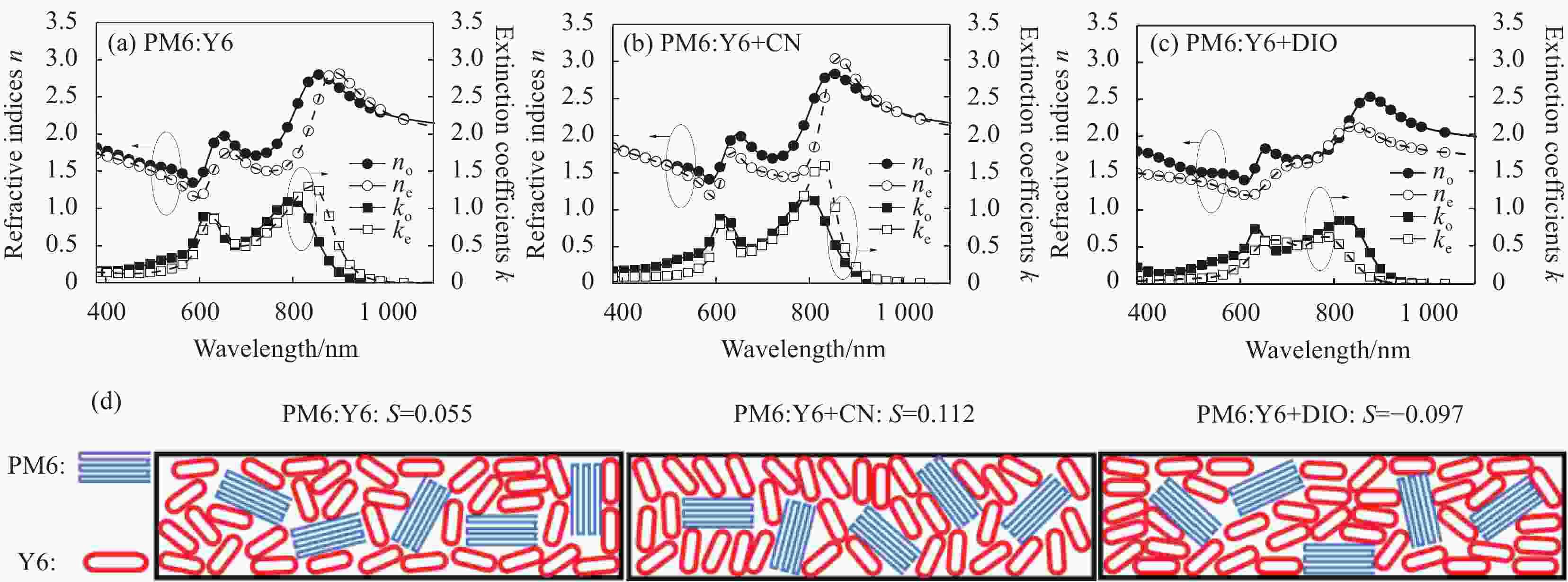Improved device performance enabled by optimized molecular orientation in organic solar cells
-
摘要: 活性层形貌对有机太阳电池的器件效率有着重要的影响。调控活性层中的分子取向是优化其形貌的方式之一。本文旨在采用Layer-by-Layer (LbL)的方法调控有机太阳电池活性层中分子的取向,进而提升电池器件的效率。通过向电子受体中加入不同的添加剂实现活性层中受体分子(Y6)的取向调节,优化后器件的能量转换效率达到16.2%。利用椭圆偏振光谱和掠入射广角X射线散射(GIWAXS)技术对活性层薄膜进行了表征,结果表明,向受体中加入1, 8-二碘辛烷(DIO)作为添加剂后,活性层中的Y6分子倾向水平取向,向受体中加入氯萘(CN)作为添加剂后,Y6分子倾向于垂直取向。电学和光学表征结果表明,Y6的水平取向增加了器件内激子的分离效率,进而提升了器件的能量转换效率。Abstract: The morphology of the active layer has an important influence on the device efficiency of organic solar cells. Tuning the molecular orientation in the active layer is one of the ways to optimize its morphology. This paper aims to use a Layer-by-Layer (LbL) method to regulate the orientation of molecules in the active layer of organic solar cells, thereby improving the efficiency of cell devices. By adding different additives to the electron acceptor, the orientation of acceptor molecule (Y6) in the active layer is adjusted, and the energy conversion efficiency of the optimized device reaches 16.2%. The active layer films were characterized by ellipsometry and grazing incidence wide-angle X-ray scattering (GIWAXS). The results show that after adding 1,8-diiooctane (DIO) as an additive to the receptor, Y6 molecules in the active layer tend to be horizontally oriented, and after adding chloronaphthalene (CN) as an additive to the receptor, Y6 molecules tend to be vertically oriented. The electrical and optical characterization results show that the horizontal orientation of Y6 increases the exciton separation efficiency, and then improves the energy conversion efficiency of the device.
-
Key words:
- organic solar cell /
- Layer-by-Layer /
- molecular orientation /
- ellipsometry /
- GIWAXS /
- acceptor molecule (Y6)
-
图 1 (a)器件电流密度-电压曲线图;(b)器件的外量子效率图(EQE);(c)受体分子(Y6)薄膜在添加不同添加剂时的紫外-可见吸收光谱图;(d)通过Layer-by-Layer (LbL)方式制备的聚合物PBDB-T-2F (PM6):Y6薄膜的紫外-可见吸收光谱图,插图为(d)图在长波峰值处的放大图
Figure 1. (a) Current density-voltage curve of device; (b) External quantum efficiency (EQE) diagram of the device; (c) UV-vis absorption spectra of acceptor molecule (Y6) film with different additives; (d) UV-vis absorption spectra of PBDB-T-2F (PM6):Y6 films prepared by Layer-by-Layer (LbL) method, Figure (d) is a magnified view at the long wave peak
图 3 PM6:Y6 (a)、PM6:Y6+CN (b)、PM6:Y6+DIO (c)三种薄膜的n、k曲线图;(d)三种薄膜中分子取向示意图
Figure 3. n and k curves of PM6:Y6 (a), PM6:Y6+CN (b), PM6:Y6+DIO (c) films; (d) Schematic diagram of molecular orientation in three thin films
no, ne—Refractive indices of light parallel and perpendicular to the plane of incidence; ko, ke—Extinction coefficients of light parallel and perpendicular to the plane of incidence; S—Hermans orientation parameter
图 4 (a) 器件光生电流-有效电压图;(b) 器件的开路电压-光强关系曲线;器件在较大有效电压(1 V) (c)和较小有效电压(0.1 V) (d)时的光生电流-光强曲线图
Figure 4. (a) Photogenerated current-effective voltage diagram of the device; (b) Open-circuit voltage-light intensity relationship curve of the device; Photogenerated current-light intensity curves of the device at a large effective voltage (1 V) (c) and a small effective voltage (0.1 V) (d)
Veff—Effective voltage; Jph—Photocurrent density
表 1 器件基本性能参数表
Table 1. Basic performance parameters of the device
PCE/% Voc/V FF/% Jsc/(mA·cm−2) PM6:Y6 15.16 0.85 68.87 25.90 PM6:Y6+CN 15.01 0.86 71.62 24.36 PM6:Y6+DIO 16.24 0.82 74.80 26.35 Notes: PCE—Power conversion efficiency; Voc—Open-circuit voltage; FF—Fill factor; Jsc—Short-circuit current density. -
[1] LI H, WANG J. Layer-by-Layer processed high-perfor-mance polymer solar cells[J]. Applied Physics Letters,2012,101(26):263901. doi: 10.1063/1.4773515 [2] TANG C W. Two-layer organic photovoltaic cell[J]. Applied Physics Letters,1986,48(2):183-185. doi: 10.1063/1.96937 [3] YU G, GAO J, HUMMELEN J C, et al. Polymer photovoltaic cells: Enhanced efficiencies via a network of internal donor-acceptor heterojunctions[J]. Science,1995,270(5243):1789. doi: 10.1126/science.270.5243.1789 [4] LIANG Y, XU Z, XIA J, et al. For the bright future-bulk hetero-junction polymer solar cells with power conversion efficiency of 7.4%[J]. Advance Materials,2010,22(20):135-138. doi: 10.1002/adma.200903528 [5] LIAO S H, JHUO H J, CHENG Y S, et al. Fullerene derivative-doped zinc oxide nanofilm as the cathode of inverted polymer solar cells with low-bandgap polymer (PTB7-Th) for high performance[J]. Advance Materials,2013,25(34):4766-4771. doi: 10.1002/adma.201301476 [6] HE Z, XIAO B, LIU F, et al. Single-junction polymer solar cells with high efficiency and photovoltage[J]. Nature Photonics,2015,9(3):174-179. doi: 10.1038/nphoton.2015.6 [7] LIN C, LIU J, HE G, et al. Non-linear viscoelastic properties of TATB-based polymer bonded explosives modified by a neutral polymeric bonding agent[J]. RSC Advances,2015,5(45):35811-35820. doi: 10.1039/C5RA05824D [8] ZHAO W, LI S, YAO H, et al. Molecular optimization enables over 13% efficiency in organic solar cells[J]. Journal of the American Chemical Society,2017,139(21):7148-7151. doi: 10.1021/jacs.7b02677 [9] CHEN D, YAO J, CHEN L, et al. Dye-incorporated poly-naphthalenediimide acceptor for additive-free high-performance all-polymer solar cells[J]. Angewandte Chemie International Edition,2018,57(17):4580-4584. doi: 10.1002/anie.201800035 [10] YUAN J, ZHANG Y, ZHOU L, et al. Single-junction organic solar cell with over 15% efficiency using fused-ring accep-tor with electron-deficient core[J]. Joule,2019,3(4):1140-1151. doi: 10.1016/j.joule.2019.01.004 [11] LIU Q, JIANG Y, JIN K, et al. 18% Efficiency organic solar cells[J]. Science Bulletin,2020,65(4):272-275. doi: 10.1016/j.scib.2020.01.001 [12] CUI Y, ZHANG S, LIANG N, et al. Toward efficient polymer solar cells processed by a solution-processed Layer-by-Layer approach[J]. Advanced Materials,2018,30(34):1802499. doi: 10.1002/adma.201802499 [13] WANG Y, ZHAN X. Layer-by-Layer processed organic solar cells[J]. Advanced Energy Materials,2016,6(17):1600414. doi: 10.1002/aenm.201600414 [14] AYZNER A L, TASSONE C J, TOLBERT S H, et al. Reapprai-sing the need for bulk heterojunctions in polymer−fullerene photovoltaics: The role of carrier transport in all-solution-processed P3HT/PCBM bilayer solar cells[J]. Journal of Physical Chemistry C,2009,113(46):20050-20060. doi: 10.1021/jp9050897 [15] LEE K H, SCHWENN P E, SMITH A R, et al. Morphology of all-solution-processed "bilayer" organic solar cells[J]. Advance Materials,2011,23(6):766-770. doi: 10.1002/adma.201003545 [16] CHENG P, HOU J, LI Y, et al. Layer-by-Layer solution-processed low-bandgap polymer-PC61BM solar cells with high efficiency[J]. Advanced Energy Materials,2014,4(9):1301349. doi: 10.1002/aenm.201301349 [17] LI Q, WANG L M, LIU S, et al. Vertical composition distribution and crystallinity regulations enable high-perfor-mance polymer solar cells with >17% efficiency[J]. ACS Energy Letters,2020,5(11):3637-3646. doi: 10.1021/acsenergylett.0c01927 [18] HU M, ZHANG Y, LIU X, et al. Layer-by-Layer solution-processed organic solar cells with perylene diimides as accep-tors[J]. ACS applied materials & interfaces,2021,13(25):29876-29884. [19] SUN R, WU Q, GUO J, et al. A Layer-by-Layer architecture for printable organic solar cells overcoming the scaling lag of module efficiency[J]. Joule,2020,4(2):407-419. doi: 10.1016/j.joule.2019.12.004 [20] REN M, ZHANG G, CHEN Z, et al. High-performance ter-nary organic solar cells with controllable morphology via sequential Layer-by-Layer deposition[J]. ACS Applied Materials & Interfaces,2020,12(11):13077-13086. [21] CHENG C H, WANG J, DU G T, et al. Organic solar cells with remarkable enhanced efficiency by using a CuI buffer to control the molecular orientation and modify the anode[J]. Applied Physics Letters,2010,97(8):083305. doi: 10.1063/1.3483159 [22] VOHRA V, KAWASHIMA K, KAKARA T, et al. Efficient inverted polymer solar cells employing favourable molecular orientation[J]. Nature Photonics,2015,9(6):403-408. doi: 10.1038/nphoton.2015.84 [23] ZHOU K, WU Y, LIU Y, et al. Molecular orientation of polymer acceptor dominates open-circuit voltage losses in all-polymer solar cells[J]. ACS Energy Letters,2019,4(5):1057-1064. doi: 10.1021/acsenergylett.9b00416 [24] LI X, DU X, ZHAO J, et al. Layer-by-Layer solution processing method for organic solar cells[J]. Solar RRL,2020,5(1):2000592. [25] PAN M A, LAU T K, TANG Y, et al. 16.7%-Efficiency ternary blended organic photovoltaic cells with PCBM as the acceptor additive to increase the open-circuit voltage and phase purity[J]. Journal of Materials Chemistry A,2019,7(36):20713-20722. doi: 10.1039/C9TA06929A [26] WIGNALL G D, LIN J S, SPOONER S. Reduction of parasitic scattering in small-angle X-ray scattering by a three-pinhole collimating system[J]. Journal of Applied Crystallography,1990,23(4):241-245. doi: 10.1107/S0021889890001984 [27] ASPNES D E, THEETEN J B, HOTTIER F. Investigation of effective-medium models of microscopic surface roughness by spectroscopic ellipsometry[J]. Physical Review B,1979,20(8):3292-3302. doi: 10.1103/PhysRevB.20.3292 [28] HAJDUK B, BEDNARSKI H, TRZEBICKA B. Temperature-dependent spectroscopic ellipsometry of thin polymer films[J]. Journal of Physical Chemistry B,2020,124(16):3229-3251. doi: 10.1021/acs.jpcb.9b11863 [29] SIRARD S M, GREEN P F, JOHNSTON K P. Spectroscopic ellipsometry investigation of the swelling of poly(dimethylsiloxane) thin films with high pressure carbon dioxide[J]. Journal of Physical Chemistry B,2001,105(4):766-772. doi: 10.1021/jp002592d [30] WOODS H J. Contribution to the physics of cellulose fibres [J]. Nature, 1946, 159: 519–520. [31] WARD I M. Structure and properties of oriented polymers [M]. Dordrecht: Springer Science & Business Media, 2012. [32] WU J L, CHEN F C, HSIAO Y S, et al. Surface plasmonic effects of metallic nanoparticles on the performance of polymer bulk heterojunction solar cells[J]. ACS Nano,2011,5(2):959-967. doi: 10.1021/nn102295p [33] KOSTER L J A, MIHAILETCHI V D, RAMAKER R, et al. Light intensity dependence of open-circuit voltage of polymer: Fullerene solar cells[J]. Applied Physics Letters,2005,86(12):123509. doi: 10.1063/1.1889240 [34] LENES M, MORANA M, BRABEC C J, et al. Recombination-limited photocurrents in low bandgap polymer/fullerene solar cells[J]. Advanced Functional Materials,2009,19(7):1106-1111. doi: 10.1002/adfm.200801514 -






 下载:
下载:






